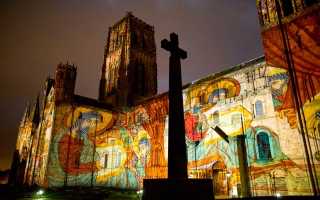Durham Cathedral welcomes the return of Crown of Light
Published: WORSHIP

WORLD: UK-based projection artist Ross Ashton recently returned to the Durham Cathedral for the 2013 Durham Lumière Festival, a four day event curated and produced by Artichoke, commissioned by the Durham City Council. ‘Crown of Light’ covered the entire North façade of the cathedral – including all sides of the three towers – and was the festival’s largest installation. It ran 20 times each night, helping to draw over 200,000 people into Durham across the four days.
‘It’s a fantastic honour to be asked back to one of the most beautiful cities in Europe with the same show, and a real testament to the popularity of the piece in 2009 and 2011,’ enthused Mr Ashton. ‘We offered all those who enjoyed it before the chance to repeat the experience, as well as attracting a new and equally as enthusiastic audience.’
The story captured the history of the cathedral including the Lindisfarne Gospels, noted for their accompanying imagery and Celtic calligraphy. Mr Ashton's show also explored the building as an architectural space and its relationship with and historical significance to the city. Mr Ashton evolved the PIGI projection images in collaboration with musical director Robert Ziegler and sound designer John Del Nero, who compiled a soundscape for the 16 minute show. Mr Ashton sourced images from the British Library and also conducted a photo shoot at the cathedral to record all the architectural and structural elements he wanted to incorporate into the show.
The projection system comprised of seven PIGI 6KW machines with double rotating scrollers, positioned at various distances around the cathedral – the longest throw distance was 150m and the shortest just 20m. This was carefully calculated to eliminate any shadowing from the plethora of trees dotted around the cathedral gardens – and was also a primary creative and technical challenge of the project.
The seven projectors, supplied by White Light, were in six different locations, fitted with five different types of lens, ranging from a 10cm wide angle lens to an 85cm long throw lens. Images from each individual machine enveloped a separate zone of the cathedral's architecture.
The PIGI film scrolls were each about 15m in length, for which the PIGI artwork assembled and pre-corrected for perspective and keystoning in Photoshop. The show was programmed into E/T/C's PC-based OnlyCue controller and operated by Karen Monid.
Projection Studio’s Steve Larkins dealt with all the project logistics, working with Erwin de Gans and Michael Barry who ran the projectors, which were all housed in custom weatherproof hides for the duration.
